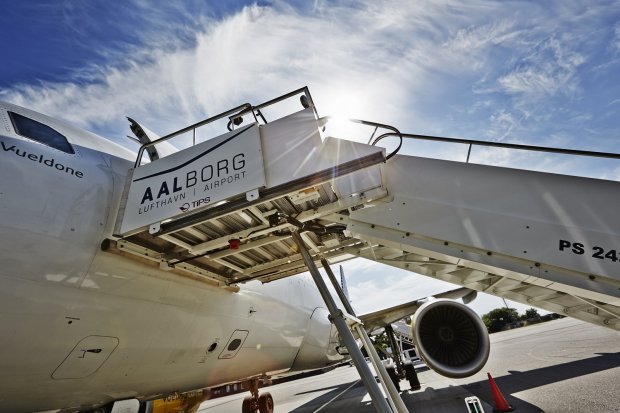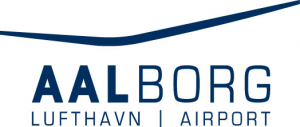A good year in Aalborg Airport

2017 in Aalborg Airport has been evaluated, and it has been a good year - with a historical record in the number of passengers, who have traveled to and from Aalborg Airport in one calender year. September 2017 became the largest month in the airport's history, while the traffic figures for 2017 generally showed a massive growth in foreign traffic. With 1,521,658 passengers in 2017, the overall result for the number of passengers is almost status quo compared to 2016 - with an increase of 0.044 percent.
The year of 2017 showed good results in Aalborg Airport, with an excellent progress in foreign traffic, but a decline in domestic and charter traffic that did not meet the great growth in 2016. 1,521,658 passengers traveled to and from the airport throughout 2017 against 1,520,987 in 2016 - an increase of 0.044 percent. Passenger numbers for 2017 are therefore almost status quo compared to the previous year, but 2017 still stands out as the biggest year ever in Aalborg Airport's history.
- A passenger increase of 0.044 percent in 2017 is status quo in relation to the number of passengers in 2016, but a new historical passenger record, and thus another milestone has been reached. As a whole, 2017 has been a really good year in Aalborg Airport. Most importantly, September 2017 became the largest month ever, but several monthly records are also found in the past year - such as December 2017, becoming the largest December to date with 107,212 passengers. In addition, for the second consecutive year, we have been ranked among the most recommended brands in Denmark - as the only regional company in the top 10, says Søren Svendsen, director of Aalborg Airport.
New hights in international traffic
International traffic has increased significantly since April 2017, where new and existing routes to Oslo, London, Amsterdam and Malaga have cemented Aalborg Airport's position as an international airport. In addition, it was announced in 2017 that there is more capacity on the Oslo route in store, so we expect a two-digit growth rate on this route in 2018. Furthermore, large numbers of growth are expected on the Antalya route and of course on the new summer route to Athens.
- The international traffic in Aalborg Airport is in a very good development, with new routes on the program and existing ones that are expanding. In 2017, this is highly evident, where we have gained more traffic to London with both Norwegian and Ryanair, four daily departures all year to Amsterdam with KLM and the new Oslo route with SAS, which has had a good start-up. With this year's massive growth in foreign traffic of 14.3 per cent, we have, as a whole, had the largest number of passengers to date who have traveled by plane to a country outside Denmark, says Søren Svendsen.
Strengths and challenges of domestic traffic
Overall, there is a slight decline in domestic traffic of 2.5 percent - compared with the sharp rise in 2016. The result should be seen in the light of the fact that there have been almost 100 fewer departures from Aalborg to Copenhagen in 2017. On the other hand, the route to Bornholm has had a great year, with full flights back and forth between Aalborg and Rønne and extra departures in the Autumn and Christmas holidays.
- The passenger traffic figures for domestic traffic in 2017 could not meet the high growth we had in 2016, but the national domestic campaign has reinvigorated the route to Copenhagen, which is expected to have effect in the new year. At the same time, we expect the tax cuts in Copenhagen Airport to have an impact on ticket prices, says Søren Svendsen.
Looking at the number of charter passengers in 2017, there has been a total decline of 11.2 percent, primarily due to a greatly reduced charter program for Turkey.
High expectations for 2018
A look forward to 2018 indicates an exciting year at Aalborg Airport with high expectations for continued growth in foreign traffic - for example, the new summer route to Athens, the now seven weekly flights to London and more traffic to Antalya, where an increase of up to 70 percent is expected. The continued growth on KLM's daily route to Amsterdam will also contribute positively. The charter program increases with five new charter destinations in Greece and more capacity on existing charter routes such as Cyprus. In addition, there are a series of new ski destinations on the program with direct flights to Innsbruck, which opens up to beautiful ski areas in Italy.
"2018 is going to be a good year at Aalborg Airport. Not only with the new routes to both charter destinations, city breaks and skiing, we can look forward to a full summer program for Bornholm and a good charter program for beautiful destinations in Spain, Portugal, Greece and Turkey, which returns as a popular holiday destination for Danes. In addition, we will upgrade our landing system in May, which allows aircraft to land in low visibility if they have the right equipment. It will be an important element in negotiating new and exciting routes from Aalborg Airport. This and the strong foreign routes to London and Amsterdam, among others, provide very high expectations for 2018, where we expect to achieve a passenger growth of 5.0 percent, meaning a total of more than 1.6 million passengers in 2018, Søren Svendsen concludes.
Traffic figures of 2017
It is the foreign traffic, which has grown most in 2017, with 420.241 passengers traveling to and from abroad this year against 367,567 in 2016 - an increase of 14.3 percent.
Domestic traffic goes back by 2.5 percent, as 886,818 passengers traveled to and from Aalborg in 2016 against 864,804 in 2017.
There is a decline in charter traffic of 11.2 percent compared with 2016. Thus, 236,613 flew to and from Aalborg Airport in 2017, where the number was 266,602 the year before.
Overall, there is a small passenger increase of 0.044 percent with 1,521,658 travelers in 2017 against 1,520,987 in 2016.


